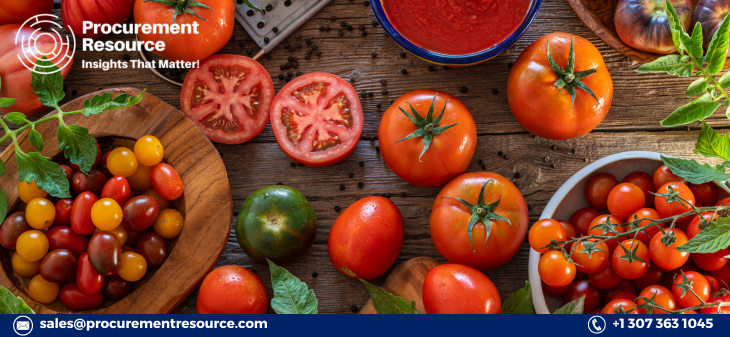Tomatoes are a staple ingredient in countless dishes worldwide, making them a crucial agricultural commodity. However, tomato prices can be unpredictable due to various factors, including weather patterns, pest infestations, supply chain disruptions, and global trade dynamics. In this blog, we’ll explore the recent trends in tomato prices, analyze the factors driving these trends, and discuss the potential future outlook for tomato prices.
1. Recent Trends in Tomato Prices
Tomato prices often exhibit seasonal fluctuations, with higher prices observed during certain months due to climatic conditions affecting supply. In 2023, for instance, tomato prices surged in various parts of the world due to unexpected weather events:
Request For Sample: https://www.procurementresource.com/resource-center/tomato-price-trends/pricerequest
- India: In mid-2023, heavy rainfall in key tomato-producing regions like Maharashtra and Karnataka caused crop damage and reduced yields, leading to a sharp spike in tomato prices. Prices in major cities like Mumbai and Delhi saw an increase of over 300% compared to the previous year’s average.
- United States: California, a major tomato-growing region, faced drought conditions in the summer of 2023, impacting production volumes. Consequently, prices of tomatoes increased by approximately 15% compared to previous years, as supply struggled to meet demand.
- Europe: Similarly, Spain and Italy, prominent tomato exporters in Europe, experienced dry spells that disrupted crop growth. This led to increased imports to meet demand, which drove prices up across the region.
2. Key Factors Influencing Tomato Prices
Understanding the factors behind tomato price fluctuations can help producers, retailers, and consumers anticipate and respond to price changes. The primary factors influencing tomato prices include:
- Weather Conditions: Tomatoes are highly sensitive to changes in weather. Too much rainfall can lead to fungal infections, while drought can cause reduced yields. Both of these weather extremes can drive up prices by reducing supply.
- Pest and Disease Outbreaks: Tomato crops are vulnerable to a variety of pests and diseases, such as the tomato leaf miner and tomato mosaic virus. Outbreaks of these pests can significantly reduce crop quality and yield, leading to price hikes.
- Transportation and Supply Chain Issues: Transportation costs and supply chain disruptions can also influence tomato prices. For instance, rising fuel prices can increase the cost of transporting tomatoes, which is then passed down to consumers. Moreover, disruptions in the supply chain, as seen during the COVID-19 pandemic, can create bottlenecks that further exacerbate price volatility.
- International Trade and Tariffs: Many countries rely on tomato imports to meet domestic demand. Changes in trade policies, tariffs, and import/export restrictions can affect the availability and price of tomatoes in the global market.
3. Global Tomato Price Forecast and Future Outlook
Given the current trends, the global tomato market is expected to experience moderate growth in the coming years. Factors such as the growing demand for processed tomato products, increased consumer awareness about organic farming, and technological advancements in agriculture will influence future prices. However, climate change poses a significant risk to stable tomato production, making prices vulnerable to unexpected spikes.
To mitigate these risks, many tomato-producing countries are investing in resilient agricultural practices and technologies. For example:
- Greenhouse Farming: Greenhouses offer a controlled environment that can protect tomatoes from adverse weather conditions and pests. This practice is becoming increasingly popular, particularly in countries like the Netherlands and Canada.
- Advanced Irrigation Techniques: Efficient irrigation systems, such as drip irrigation, help conserve water while ensuring optimal growth conditions for tomatoes. This is particularly relevant in water-scarce regions, where drought conditions can severely impact yields.
- Disease-Resistant Varieties: Researchers are developing tomato varieties that are resistant to common pests and diseases. By using these varieties, farmers can maintain stable yields, even in the face of pest outbreaks.
4. What Can Consumers Expect?
For consumers, tomato prices may continue to experience seasonal fluctuations, with potential price spikes during adverse weather conditions. To manage these changes, consumers can consider purchasing local, seasonal tomatoes and exploring alternative sources such as frozen or canned tomatoes, which often have more stable prices.
Additionally, supporting sustainable agricultural practices can help ensure a stable tomato supply in the future. Choosing products from companies that invest in environmentally friendly farming practices contributes to a more resilient food system.
The tomato market is subject to a range of factors that influence prices, from weather and pests to transportation costs and international trade dynamics. While seasonal fluctuations are expected, ongoing investments in agricultural technology and sustainable practices may provide a buffer against extreme price swings in the future. Staying informed about the factors driving tomato price trends can help consumers, businesses, and policymakers make more informed decisions and adapt to changes in the global market.
Contact Us:
Company Name: Procurement Resource
Contact Person: Endru Smith
Email: sales@procurementresource.com
Toll-Free Number: USA & Canada - Phone no: +1 307 363 1045 | UK - Phone no: +44 7537 132103 | Asia-Pacific (APAC) - Phone no: +91 1203185500
Address: 30 North Gould Street, Sheridan, WY 82801, USA



